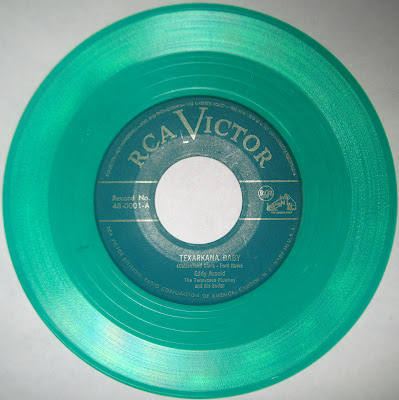|
Moderated by NW Okie! |
Volume 16 , Issue 172014Weekly eZine: (371 subscribers)Subscribe | Unsubscribe Using Desktop... |
45, 78 & 33-1/3 RPM Records (Battle of the Speeds)

It was on 31 March 1949, RCA Victor released the first 45rpm record, "Texarkana Baby," b/w "Bouquet of Roses" by Eddy Arnold.
The demonstration record that came with one of RCA Victor's 1949 preview of "The World's Fastest Record Changer." The RCA 45rpm record and players did have a few problems, though. The player could only play 45rpm records. And classical music fans still had to put up with the same mid-movement breaks that plagued symphonic fans since the dawn of classical recordings.The 33-1/3 rpm record rarely had this problem, though.
Did you know that the number "45" came from taking 78, subtracting Columbia's new "33" to equal the "45." Some would wonder which format would survive: The 78rpm or the 45rpm. The 45rpm record initially introduced in 1949 by RCA Records was a smaller, durable replacement for the heavy 78 shellac-based records of that era.
The 45 was created by RCA as a competitive move against one their rival record companies, Columbia, which had introduced the new microgroove 33 1/3 rpm LP.
The era at the turn of the 1950's was known as the "Battle of the Speeds." By 1954 more than 200 million 45s had been sold. Some people preferred the 33-1/3rpm LP, while others preferred the new 45rpm players and the old timers insisted on the 78rpm speed. 78's began disappearing in the early 1950's The last American commercially released 78rpm singles appeared in 1959, but they were still made for children's records and older jukeboxes until 1964.
The length of the songs on the 45rpm also evolved. In the 1950's, it was common for songs to be anywhere from two to two and a half minutes long. In the 1960's, the three minute single became the norm.
The RCA 7-inch 45 rpm was supposedly cute, very small, and very colorful vinyl. Each genre of music had its own color of vinyl. It made an instant hit with younger people. Popular releases were on standard black vinyl. Country releases were on green vinyl. Children's records were on yellow vinyl. Classical releases were on red vinyl. Race or R&B and Gospel records were on orange vinyl. The blue vinyl/blue label was used for semi-classical instrumental music, while blue vinyl/black label was used for international recordings. RCA eventually ended it's colored vinyl lines due to the price of the colored vinyl compared to the standard black.
Remember when 45's were so cheap, less than a dollar each, and fun to collect, share and trade with friends? Back in the era of 45rpm records there were also portable battery operated phonographs so you could take your music with you anywhere. Today we have mp3, CD/DVD's.
| View or Add Comments (0 Comments)
| Receive
updates ( subscribers) |
Unsubscribe
| © . Linda Mcgill Wagner - began © 1999 Contact Me | |
